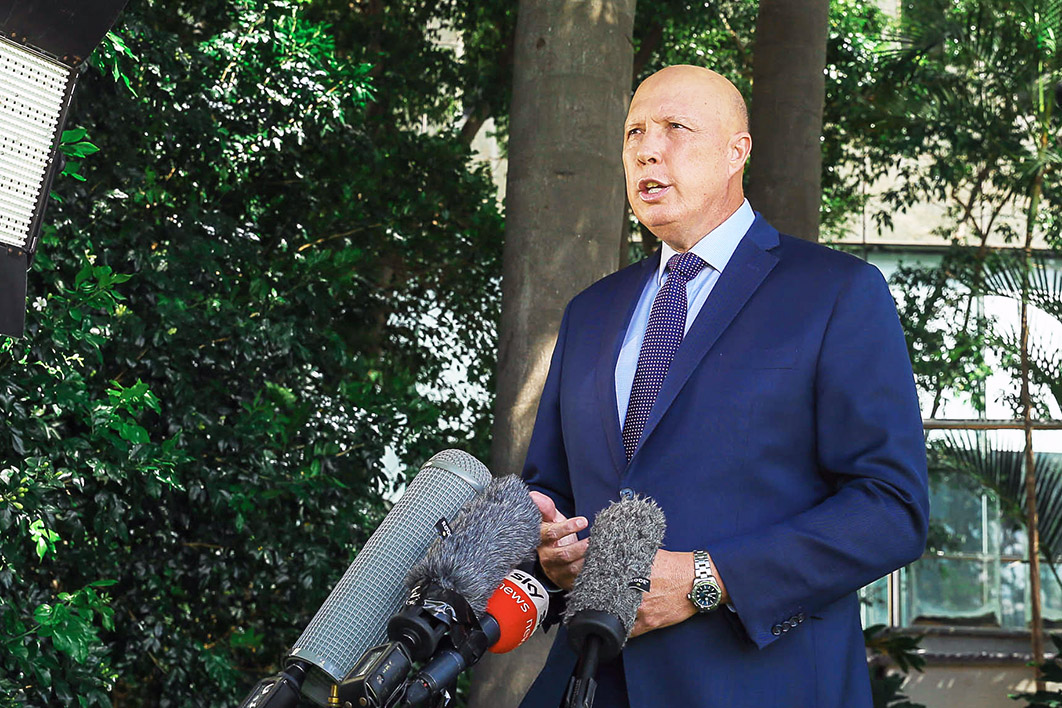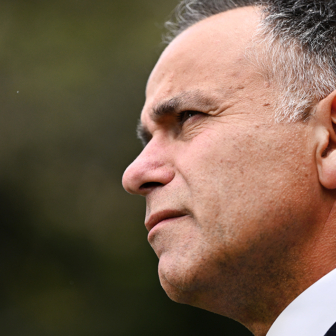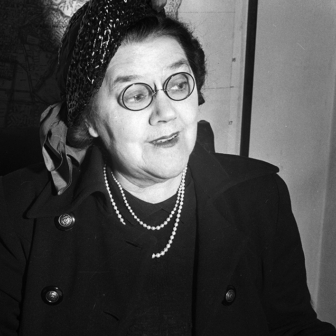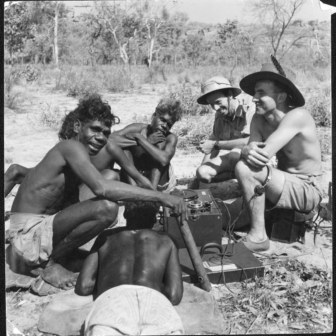“Almost every major institution in our society supports The Voice: woke big business, Big Tech, the mainstream media, civic organisations, sporting codes, places of worship, as well as schools and universities,” the Institute of Public Affairs’s Daniel Wild lamented in October last year. “The deck is being stacked against Australians who believe in racial equality and do not think that extra political and legal rights should be accorded based on race or ancestry.”
For Wild and other opponents of the Indigenous Voice, only one hope remains. Will the Liberals join the Nationals and campaign for a No vote? The widely held belief that referendums fail without the support of both major parties has given Peter Dutton’s Liberals an aura: when we know their position we will know the result.
The Nationals have already demonstrated how costly it can be to take a clear position on this referendum. Putting themselves in the No camp at the end of November, they immediately lost one of their MPs, Andrew Gee, to the crossbench. The National Farmers’ Federation, pondering the diversity of rural opinion, has since decided that it will endorse neither Yes nor No.
Will David Littleproud relish sharing a podium with Pauline Hanson at No rallies in the bush? He would certainly feel more comfortable with Dutton at his side.
Some see an implicit No stance in the letter Dutton sent to prime minister Anthony Albanese on 7 January, in which he asked fifteen questions about the design of the Voice. Until the government answers those questions, Dutton declared, the Liberals can’t say whether they will endorse Yes or join the Nationals and One Nation in the No camp.
While we puzzle over the parties’ alignments on the proposed constitutional amendment, we shouldn’t forget their common ground. Liberals, Nationals and Labor all agree that Australian governments need advice from an Indigenous Voice. The Coalition government committed $31.8 million in March last year to setting up such a body; it then lost office to a Labor Party that promised to defer creating an Indigenous Voice until after a referendum confirms that the electorate wants it embedded in the Constitution.
Since the change of government, both Jacinta Nampijinpa Price and Peter Dutton have declared that Labor should legislate now, rather than waiting for a referendum, if it believes in the Voice.
So what is the underlying, longer-term debate about the Voice really about? In essence, the major parties differ on two questions. First, what form should constitutional recognition of Indigenous Australians take? Both sides say they want the Constitution to recognise Indigenous Australians in some way, but the conservative parties insist that enshrining the Voice in the Constitution is a bad way to do it.
Then there’s the design of the Voice itself. Labor insists that this discussion be deferred until after the referendum, when parliament will consider a yet-to-be-written bill. Others want to start the design conversation now. Even those on the right who want to see the referendum carried — people like legal scholar Greg Craven, Liberal MPs Julian Leeser and Andrew Bragg, and journalist Chris Kenny — have either raised questions about the shape of the Voice or asked for the government to publish a draft bill.
These questions have exasperated many of the people committed to voting Yes in Labor’s referendum. Asking the government to detail the form and functions of the Voice is bad faith, they say; the Liberals are needling the Yes campaign without defining their own stance. They fear that to answer every question now will plunge supporters of Yes into dispute with each other, and that some Yes voters, not liking the answers, will defect to No.
Dutton undoubtedly profits by continuing to ask questions about Voice design. He can avoid alienating Liberals who want a constitutionally enshrined Voice while keeping at bay the Liberals who, for a variety of reasons, would like to join the Nationals in the No camp. But characterising his questioning as a political tactic is persuasive only up to a point. What it overlooks is the fact that a debate about Voice design is already under way — a debate that some wish to suppress for now, and others wish to join.
From the Liberals’ point of view, creating a debate about Voice design makes sense, no matter what position they take on the referendum. A legislated Voice is likely, whether or not the Yes case wins, because both Labor and the Coalition want one. The conservatives are seeking Labor’s commitment to a Voice of a certain kind — a Voice that resembles, in some respects, the body that they began to design in 2016 (by some accounts, as long ago as 2013).
Dazzled by the apparent belligerence of Dutton’s 7 January letter to Albanese, some commentators have not noticed the punches it pulled.
Many on the right — journalists Peta Credlin, Janet Albrechtsen, Andrew Bolt, Piers Akerman and Greg Sheridan, for instance, and former PMs Abbott and Howard — have been publicly counselling Dutton to oppose the Voice as a “race-based” assault on liberal equality. Yet Dutton’s questions made no appeal to a principle of formal equality and avoided the “race-based” tag.
Nor did he raise the threat to parliamentary sovereignty some believe would be posed by the High Court. Anti-Voice conservatives have asserted that Albanese’s constitutional amendment — no matter how cleverly worded — will encourage litigation. Litigants will demand and receive the High Court’s help in intensifying the government’s obligation to listen and respond to the Voice and to license it to choose whatever matter it wishes to speak on.
Instead of taking up these fears, Dutton’s letter and questions essentially linked the effectiveness or otherwise of the Voice to its representativeness.
His first three questions concerned who can vote for and serve on the Voice. Questions four, nine and ten were about election/appointment and ongoing accountability. Question eleven named a constituency that the Voice must be designed to represent: “those who still need to get a platform in Australian public life.”
Questions twelve and fifteen hinted at what the Voice should be concerned with (closing the gap and “the real issues that impact people’s lives daily on the ground in the community”); question thirteen invited the government to assure us that the Voice would not negotiate a treaty.
Dutton’s polemical phrasing stoked anxiety about several questions. But they are nonetheless matters of structure and purpose, and they embody an underlying idea: that the Voice will not help the most disadvantaged unless it is designed to amplify their influence on governments.
So it is significant that Dutton’s fourteenth question linked this ethically attractive idea to an actual design proposal: “Will the government commit to Local and Regional Voices, as recommended in the report on the co-design process led by Tom Calma and Marcia Langton?”
That is a confronting question for Labor, which has sought to say as little as possible about Calma and Langton’s report since it was released in December 2021. Albanese said immediately after his Garma speech that the report was central to his government’s thinking, but neither he nor Indigenous Australians minister Linda Burney has revealed which features of the model the government does and doesn’t like. Albanese’s recent radio interview with Ben Fordham revealed that he does not have some features of the Calma–Langton model at his fingertips.
The plan for Patrick Dodson, chair of the joint parliamentary committee on Aboriginal and Torres Strait Islander Affairs, to circulate a substantial outline of the Voice by Christmas 2022 seems to have been dropped, though it has been minimally fulfilled by Burney’s listing of several design principles: that the Voice will be advisory, will not deliver programs, will not have a veto over parliament, will be “accountable and transparent,” will be chosen by First Nations people, will be gender-balanced and will include young people.
Calma and Langton went much further than this. In particular, they presented the thirty-five Local and Regional Voices as the foundational tier of the Voice, and argued that this tier must thus be created first. Only when the “vast majority” of Local and Regional Voices are in place, they said, will it be possible for the National Voice to be added — perhaps two years after work on the Local and Regional Voices had begun. (Until then, they suggested, there would be an Interim National Voice.)
It made sense to defer the National Voice, they pointed out, because its members should be chosen by the Local and Regional Voices rather than by the votes of a national Indigenous electorate. In Calma and Langton’s conception, the National Voice gets its representative legitimacy from the Local and Regional tiers that precede it and on which it depends.
Calma and Langton say that the thirty-five Local and Regional Voices will not arise de novo but should build on and extend “existing local and regional decision-making arrangements.” As examples they mention the NSW Local Decision Making initiative and the national Empowered Communities scheme — the latter giving their plan a conservative lineage, for it was established by the Turnbull government in 2016.
Empowered Communities sought to cultivate “partnerships” between government and community in eight regions: Cape York, NSW Central Coast, Inner Sydney, Goulburn Murray, East Kimberley, West Kimberley, Ngaanyatjarra Pitjantjatjara Yankunytjatjara Lands, and Ngarrindjeri. The scheme analysed data, built “baselines” and identified “service delivery gaps” in order to produce “long-term Regional Development Agendas.”
In some of the Empowered Communities the Morrison government quarantined welfare payments through the Cashless Debit Card. When Labor abolished the CDC in September 2022, some critics argued that the government had failed to heed the wishes of many in those regions.
Within the Turnbull and Morrison governments, Empowered Communities were seen as promising exercises in forming what Calma and Langton would come to call Local and Regional Voices. But Liberal MP Tim Wilson doubted in August 2018 that anything would be gained from giving constitutional recognition to such bodies: they got their legitimacy, he asserted, from their representativeness.
By the time the Coalition’s Aboriginal Australians minister Ken Wyatt convened his co-design committees in early 2020, the Morrison government seemed to be anticipating that the regional structures of the Voice would resemble and build on the “partnership” forums of the Empowered Communities program. Empowered Communities were among the seeds from which Calma and Langton expected Local and Regional Voices to grow. But Wyatt’s terms of reference prevented them from advocating for their model of the Indigenous Voice to be constitutionally enshrined.
Only a few months before the Morrison government lost office, Calma and Langton were arguing that the Voice should be legislated so that voters would get to know it as a useful rather than threatening part of Indigenous politics before any constitutional referendum. Wyatt didn’t get his wish to legislate on the basis of their report, but Langton publicly welcomed the last Coalition budget’s allocation of money towards what Wyatt called “more detailed co-design of implementation requirements for each jurisdiction” so that Local and Regional Voices could be formed.
As Australia passed from Coalition to Labor rule, the conservative provenance of the Calma and Langton model made referring to it politically awkward. Calma and Langton have continued to promote it, but they have adjusted their advocacy to the new sequence: their report is to be read now but acted on only after the referendum.
Without dismissing it, some advocates of a Yes vote treat the Calma–Langton model with great reserve. The co-chair of the Uluru Dialogue, Megan Davis, subtly distanced herself by referring to it as “the Wyatt report.” “There are many useful aspects of the Wyatt report that will inform the way forward,” she wrote in July 2022.
Davis’s wariness about the “Wyatt report” would be evident to anyone who noticed how Calma and Langton had responded to her proposal to the co-design committee that the National Voice have the “powers and privileges of a parliamentary committee to compel people to appear as witnesses or produce documents.” Reporting to a conservative government, Calma and Langton had thought it prudent to label that an “inquisitorial” approach and to suggest that a “good-faith partnership” was a better option.
The feature of the Calma–Langton model that (probably) endeared it most to the Morrison government was the emphasis on the Local and Regional tier: the thirty-five Voices that would speak to state, territory and local governments about programs and development opportunities.
But in the eyes of some who want an Indigenous Voice to Parliament, the Calma–Langton model does not show how regions can be represented. In the Sydney Morning Herald in August 2022, lawyer Teela Reid wrote that “each First Nation ought to have input” and therefore that “First Nations people want a nation-based Voice.” She described as “artificial” the local, regional and state boundaries “endorsed in the government report into the Voice co-design process by Marcia Langton and Tom Calma.”
A month later, Davis and fellow lawyers Gabrielle Appleby and Sean Brennan released a paper, “Finalisation of the Voice Design,” in which they acknowledge the persistence of public demands for more information about the Voice. While referring respectfully to the Calma–Langton report, their paper warns us not to consider as “final” the model it produced. They have “process-related concerns” about the report.
Appleby, Brennan and Davis want to rule a line under all the design thinking done during the Coalition government and enunciate design principles reflecting the possibility of the Voice being a constitutionally based body. In particular, they depart from Calma and Langton’s emphasis on the Local and Regional tier.
“The Voice is primarily a Voice to Parliament,” they write, “informing the ultimate national law-making authority, but it must also be engaged with government in the development of policies and legislative proposals” (my emphasis). They also want the government and parliament to have “an obligation to engage with the Voice in certain defined areas” (my emphasis).
Appleby, Brennan and Davis observe that no report has ever outlined a body that — by virtue of the referendum — is to be a constitutional entity giving Indigenous Australians constitutional recognition. This unprecedented design task, they say, requires significantly augmenting the work of parliament by a process of Indigenous consultation. They outline their preferred process and argue it should be “set out in a bill that is passed by parliament and (in an uncommenced form) is an Act available to the public voting at the referendum” (my emphasis).
Under this legislation an appointed Voice Design Council, guided by an Indigenous Steering Committee, would conduct regional dialogues at which First Nations delegates would deliberate on the design of the First Nations Voice. These dialogues would culminate in a National Convention that would write drafting instructions for the bill. The Indigenous Steering Committee would then work with the Office of Parliamentary Counsel to draft the bill. A joint parliamentary committee would consider public submissions and then recommend to parliament that it pass the final bill.
The Albanese government has not commented on this proposal for a post-referendum design process, but it continues to promise “consultation” before it presents a bill to parliament. Without disputing that parliament will write the Voice legislation, Appleby, Brennan and Davis have spelled out who should be consulted and the form that “consultation” would take: “Sufficient assurance must be given to First Nations people that the design of the Voice… will not be imposed on them by the parliament without their input.” That assurance, they say, should take the form of an act of the parliament.
By proposing a post-referendum “consultation” process that resembles the dialogues orchestrated by the Referendum Council in 2016 and 2017, Appleby, Brennan and Davis are hoping that the process that produced the Uluru Statement from the Heart is widely respected. They are banking on the possibility that the 2016–17 sequence of regional dialogues and its crowning national assembly has become paradigmatic of the Indigenous public.
“Recognition” implies there is such a thing as an Indigenous public that can accept or decline the proposed terms of recognition. But the “Indigenous public” is no more than a rhetorical construct unless it finds credible institutional expression. Until there is a Voice, this is what the series of Indigenous assemblies can be. Indigenous assemblies are currently the only political technology that can credibly answer the question: in what terms do Indigenous Australians want to be recognised?
In laying out their preferred post-referendum process, Appleby and her colleagues give less emphasis to the law-making sovereignty of the parliament, though they don’t dispute it. Their bid to write Indigenous assemblies into the post-referendum design process asserts an Indigenous prerogative we are at risk of not making room for: the prerogative to say yes or no to the offered recognition.
For “recognition” to be effective, the recognised must determine its terms. Appleby, Brennan and Davis are reminding us that this amendment, unlike any constitutional amendment in Australia’s history, will work only if it empowers an Indigenous interlocutor to say whether the recognition afforded by Australian voters is a recognition worth having.
Australians’ evident willingness to recognise Indigenous Australians in some way has empowered those to be recognised. The current diversity of viewpoints among Indigenous figures (Price, Davis, Lidia Thorpe, Nyunggai Warren Mundine and others) may dismay some as a cacophony. But the fact that Indigenous Australians are now disputing with one another about what would be recognition’s optimal form is one manifestation of their empowerment as the soon-to-be-recognised.
Mundine has spent the past twelve years letting us know his reservations about constitutional recognition, and about the Voice in particular. But he has also said recently that if the Voice is established he will contribute to making it work in order to get government “off our backs.”
Lidia Thorpe wants a truth-telling process, a treaty that recognises sovereignty and then — only then — a Voice, but we can be sure that if a Voice is established first she will assess its usefulness to her sovereignty agenda. With her strong commitment to women and children, Jacinta Price is unlikely to neglect a Voice as a means of formulating social policy — including (possibly) a revival of something like the Cashless Debit Card.
When Labor faces Liberals’ demands for detail — as it is likely to do right up until the day of the referendum — it will have to summon the nerve to continue offering only broad answers. A minimalist approach to releasing “details” will allow for a post-referendum process of further Indigenous deliberation about what kind of Voice is wanted.
While Linda Burney has mostly shown the stomach for minimalism, she has sometimes sought to appease questioners by assuring them that the Voice will deal with education, health, housing, domestic violence, childcare, native title, land rights, cultural water allocations, and other policies that have a “direct effect” on Indigenous Australians — and not “things like taxation or defence.” I suspect that her Indigenous advisers — especially Davis — have warned her against sliding into such pre-emptive talk.
Meanwhile, invoking the voters’ right to know what they are voting on, Dutton and others will solicit all the pre-emption they can get. Their pressure was evident in Julian Leeser’s announcement on Saturday that his support for Yes is weakening in the absence of Labor’s answers to Dutton’s questions. The Coalition parties will store up every “detail” they extract so they can point to it after the referendum as a design feature already endorsed (or rejected) by the Australian public.
The politics of Voice design has already begun. Whether the Liberals decide on a Yes, No or “free vote” approach to the referendum, the one thing that matters to conservatives now is to concede as little as possible of the Voice design process to those who seek to be recognised. •




